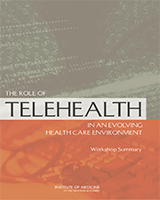NCBI Bookshelf. A service of the National Library of Medicine, National Institutes of Health.
Board on Health Care Services; Institute of Medicine. The Role of Telehealth in an Evolving Health Care Environment: Workshop Summary. Washington (DC): National Academies Press (US); 2012 Nov 20.

The Role of Telehealth in an Evolving Health Care Environment: Workshop Summary.
Show detailsAsynchronous is a term sometimes used to describe store and forward transmissions of medical images or information because the transmission typically occurs in one direction at a time.
Digital Imaging and Communication in Medicine (DICOM) is a standard for communications among medical imaging devices; a set of protocols describing how images are identified and formatted that is vendor dependent and developed by the American College of Radiology and the National Electronic Manufacturers Association.
Distant site is defined by CMS as the telehealth site where the provider/ specialist is seeing the patient at a distance or consulting with the patient’s provider. Other common names for this term include hub site, specialty site, provider/physician site, and referral site. This site may also be referred to as the consulting site.
Hub site, see distant site.
Internet protocol (IP) is the protocol by which data are sent from one computer to another on the Internet. Each computer on the Internet has at least one address that uniquely identifies it from all other computers on the Internet. IP is a connectionless protocol, which means that there is no established connection between the end points that are communicating. The IP address of a videoconferencing system is its phone number.
Mobile telehealth (mHealth) is the provision of health care services with the assistance of a van, trailer, or other mobile unit in which the health care provider might provide patient services at a distance from a normal medical facility. Services may also be provided through mobile technologies that allow a mobile vehicle equipped with medical technologies to attach to an existing health care facility.
Originating site is defined by CMS as where the patient and/or the patient’s physician is located during the telehealth encounter or consult. Other common names for this term include spoke site, patient site, remote site, and rural site.
Remote patient monitoring is the use of devices to remotely collect and send data to a monitoring station for interpretation.
Spoke site, see originating site.
Store and forward (S&F) is a type of telehealth encounter or consult that uses still digital images of a patient for the purpose of rendering a medical opinion or diagnosis. S&F also includes the asynchronous transmission of clinical data from one site (e.g., patient’s home) to another site (e.g., home health agency, hospital, clinic).
Telemedicine and telehealth both describe the use of medical information exchanged from one site to another via electronic communications to improve the patient’s health status. Although evolving, telemedicine is sometimes associated with direct patient clinical services and telehealth is sometimes associated with a broader definition of remote health care services.
Videoconferencing is the real-time, generally two-way transmission of digitized video images between multiple locations; this uses telecommunications to bring people at physically remote locations together for meetings.
Footnotes
- 15
These terms are as defined by the American Telemedicine Association, and do not represent any consensus of the participants of this meeting on their definitions (ATA, 2012a,b).
- Definitions - The Role of Telehealth in an Evolving Health Care EnvironmentDefinitions - The Role of Telehealth in an Evolving Health Care Environment
Your browsing activity is empty.
Activity recording is turned off.
See more...